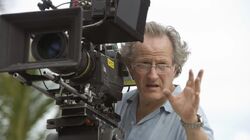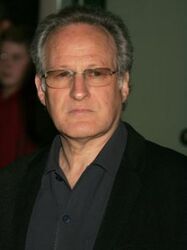|
Michael Mann
| |
|
Miami Vice Executive Producer
|
|
|
Miami Vice Director
|
|
|
Miami Vice Writer
|
"Golden Triangle (Part II)" (with Maurice Hurley)
|
|
Born
|
February 5, 1943, Chicago, Illinois
|
|
Active
|
1971-present
|
|
Spouse/Children
|
Summer Mann (1974-present), 4 children
|
Michael Kenneth Mann (born February 5, 1943) is an Academy Award-nominated director, producer, and screenwriter, who served as Executive Producer of the TV show Miami Vice for its' entire five season run, and co-wrote (with Maurice Hurley) the episode "Golden Triangle (Part II)". He is often considered the "godfather" of Miami Vice, despite the fact he neither created the show nor directed any of its episodes, although he did direct the 2006 film adaptation of the television series.
Early career[]
Mann was born in Chicago, Illinois. While studying at the University of Wisconsin, Mann saw director Stanley Kubrick's seminal Dr. Strangelove and began to take an interest in movies; he moved to London to attend graduate school in cinema, eventually earning a graduate degree from the London Film School. His first work was in television commercials, before making two short films, Insurrection (a documentary about the student riots in Paris in 1968) and Jaunpuri (a film about his experiences whilst making Insurrection). Jaunpuri won him his first award at the Cannes Film Festival.
In 1975 he returned to the US and began writing for TV shows there. His earliest stories were featured on Starsky and Hutch (with Paul Michael Glaser, David Soul, and Antonio Fargas), Police Story, and the pilot of the series Vega$. His first directorial role was in Police Woman, then the TV movie The Jericho Mile (with Brian Dennehy and Miguel Piñero). At the dawn of the 80s he made his break onto the big screen, writing and directing Thief (with Chuck Adamson, Dennis Farina, John Santucci and Tom Signorelli) in 1981. Aside from introducing Mann's trademark attention to detail, the film is notable for the extraordinary coincidences surrounding its cast, largely stemming from Mann's love of employing the right people for technical authenticity—Santucci was a jewel thief before he became an actor and technical advisor and was actually arrested by Farina while the latter was a Chicago police officer. Furthermore, the main heist in Thief, involving the use of a thermal lance to cut through a vault door, was based on a real-life robbery orchestrated by Santucci. Many of the other tools used in robberies throughout the film were also Santucci's own.
Miami Vice[]
After Thief, Mann returned to television, serving as producer (later executive producer) of the show Miami Vice in 1984. Despite never taking a directorial role on the series, Mann went to great lengths to ensure the show was aesthetically appealing and, more importantly, visually unique. His simple instructions to the production team insisted that "no earth tones" be used. Mann personally researched the Miami area for shooting locations and to capture the lifestyle of the city, and many dilapidated Art Deco buildings were restored and repainted to fit the shots he called for. As a result of Mann's intense work (and his sense of neo-noir), Vice shot into the Top 10 in the summer of 1985, during the reruns of its first season.
After the show's highest-rated second season, NBC asked Mann to launch another show, resulting in Crime Story. The series was again about cops pursuing affluent villains, but this time focussed on officers from Chicago in the 1960s chasing the mafia, first in their home town and later to the casino outfit in Las Vegas. Perhaps the series' most innovative feature was its pioneering use of season-long character development and story arcs, common in the television dramas of today but unheard of when the show was made. Mann gave up his line producing duties on Vice to concentrate on Crime Story, which premiered in 1986 with a pilot episode directed by Abel Ferrara. At the same time he also went to work on his second feature film, Manhunter, the first Hannibal Lecter movie and a film which shared many stylistic similarities with Miami Vice, as well as a surprising array of Vice guest stars, including Garcelle Beauvais, Chris Elliott, Dennis Farina, Kim Griest, Michele Shay, Jim Zubiena and even series regular Michael Talbott. Following his departure from Vice, Mann handed production duties to Dick Wolf, who shifted the appearance away from Mann's famous pastels to darker colors, and the stories from light-hearted fare to darker, grittier episodes with increasing violence.
After Vice[]
Crime Story lasted until 1988, when falling ratings in its second season led to the show being cancelled, despite the fact it had ended on a cliffhanger (as had Vice that season). Mann decided not to return to Miami Vice full-time as it was clear that that show too would finish after its fifth season. He did, however, retain his executive producer title, and in its final two seasons Vice recaptured some of the style it had featured in its early days under his supervision. Mann concentrated on other projects, including the TV movies L.A. Takedown (scored by Tim Truman) and Drug Wars: The Camarena Story, and also directed the feature films The Last of the Mohicans, Heat (a remake of L.A. Takedown, with Xander Berkeley, Martin Ferrero and Mykelti Williamson), and The Insider (with Philip Baker Hall and Bruce McGill). The Last of the Mohicans won an Oscar for best sound, while The Insider was nominated for seven Oscars, including one for Mann as Best Director; despite the critical acclaim the film received (with many critics deeming it to be Mann's greatest work) it did not win any Academy Awards.
In the 2000s, Mann directed the biopic Ali and Collateral (with Jamie Foxx, Barry Shabaka Henley and Bruce McGill), both of which received two Oscar nominations but again failed to secure any wins. In line with Mann's love of unique visuals, Collateral was also the first motion picture to be filmed almost exclusively with digital cameras, and the resultant style was highly praised. Around the same time, Mann also produced The Aviator, which won five Oscars and was nominated for a further six, and a third television series, the short-lived Robbery Homicide Division (with Barry Shabaka Henley), which, despite good ratings and a warm critical reception, was cancelled after just a single season (allegedly because of star Tom Sizemore's arrest on drug charges).
Miami Vice Film Adaptation[]

Mann working on the Miami Vice film
In 2006 Mann returned to the show that made him famous, Miami Vice, for the movie adaptation of the series, starring Colin Farrell and Jamie Foxx as Crockett & Tubbs. The film received somewhat mixed reviews, although opinion has warmed somewhat since its release, and the use of digital cameras was again praised for giving the film a crisp, distinct look, particularly in night-time scenes. Mann's most recent motion picture was 2009's Public Enemies (with John Ortiz), which was once again shot digitally. Subsequently, he directed the pilot episode of the 2012 cable series Luck (with Farina), a show that he also produced. Ratings were good and the show was quickly renewed for a second season, but the series was cancelled altogether before filming of its second season could start after three horses died during the show's production.
Style[]
Michael Mann is known for the distinctive and uncompromising style he brings to his projects. His movies (and much of his work on television) incorporate high levels of technical realism, and he often employs people with real-world experience to oversee such aspects—Jim Zubiena, renowned for his extreme proficiency with firearms, and John Santucci, an ex-jewel thief, are both frequent Mann collaborators and technical advisors.
Image and sound are also important and distinctive parts of a Michael Mann production. He often uses color to evoke a particular mood or theme in a scene, and has frequently pioneered new visual styles throughout his career—from the cool pastels of Miami Vice to the digital filming employed on his most recent motion pictures. In fact, visual style is one of the most highly praised aspects of Mann's career (although, conversely, he is sometimes criticised for investing more effort in visuals than plot or character development). With regards to sound, Mann often imparts his films with memorable soundtracks, from Tangerine Dream's electronic score in his first theatrical feature Thief to the new-age music used in Manhunter. Miami Vice and Crime Story also incorporated contemporary music in a way rarely seen on television at the time, with Vice in particular becoming famous for its extensive use of popular music.
Personal life[]
Mann married his wife Summer in 1974, and they have four children.
